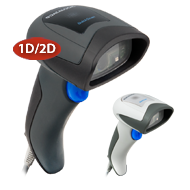Wasp Barcode Technologies: The Barcode Solution People
Compare 1D and 2D Barcode Scanners
To compare 1D and 2D barcode scanners, it’s helpful to know which
scan engine reads what type of barcode.
1D barcode scanners
Laser scanners are the most popular type of barcode scan engine because they can scan barcodes at distances greater than two feet. However, they only read
linear, or one-dimensional (1D), barcodes such as UPC-A, which is widely used by retailers and grocers.
Another example of a 1D scanner is a
linear imager. Unlike a laser scanner—which uses a beam and mirrors to read barcodes—a linear imager captures an image of a 1D barcode to read it. Linear imagers are a great option when scanning barcodes that are less than two feet away.
2D barcode scanners
[caption id="attachment_3389" align="alignright" width="190"]

The Datalogic QD3400 is a 2D, general purpose barcode scanner that is used for a variety of tasks.[/caption]
Two-dimensional (2D) scanners can read both 1D and
2D barcodes. They can also read damaged or poorly printed barcodes, which makes them ideal for environments where reliability and flexibility are important.
Companies with field service personnel prefer
2D barcode scanners because they can capture images of documents and signatures, which minimize their risk of fraud. They can also read barcodes from any angle for complete and accurate scans.
Learn more about barcode scanners.
Which is best for you?
Because of their versatility, 2D barcode scanners are quickly replacing 1Ds as the scanner of choice for most organizations. However, they aren’t always a perfect fit for everybody.
To determine whether you need a barcode scanner with a 1D or a 2D scan engine, compare common features below. If you still need help, contact System ID at 1.855.484.8149.
|
FEATURE
|
1D
SCANNER
|
2D
SCANNER
|
|
Reads 1D barcodes
|
ü
|
ü
|
|
Reads 2D barcodes
|
X
|
ü
|
|
Offers corded and cordless models
|
ü
|
ü
|
|
Comes in a variety of form factors
|
ü
|
ü
|
|
Uses popular cable interfaces such as USB
|
ü
|
ü
|
|
Reads damaged or poorly printed barcodes
|
X
|
ü
|
|
Decodes barcodes from any angle (omnidirectional)
|
X
|
ü
|
|
Processes barcodes faster
|
X
|
ü
|
|
Improves accuracy
|
X
|
ü
|
|
Captures digital images of documents and signatures
|
X
|
ü
|
|
Reads QR codes, which are widely used by today’s marketers
|
X
|
ü
|
|
Scans codes on reflective surfaces
|
X
|
ü
|
|
Supports OCR fonts
|
X
|
ü
|
|
Includes options for reading at long ranges
|
X
|
ü
|
|
Enables mobile couponing
|
X
|
ü
|
|
Encodes significant amounts of data
|
X
|
ü
|
|
Supports Direct Part Marking (DPM) for permanent tracking
|
X
|
ü
|
|
Future proofs organizations
|
X
|
ü
|



